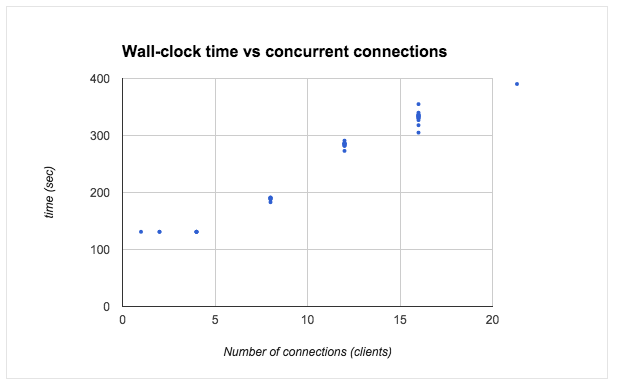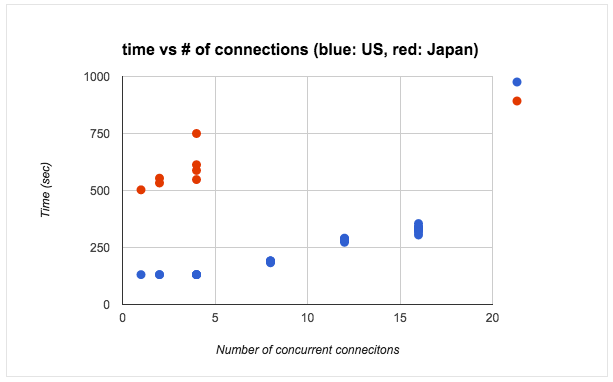Network Programming - Server & Client B : File Transfer

In this chapter, we're going to extend Python Network Programming I - Basic Server / Client A, and try to file transfer from a server to numerous clients. The main purpose is to check the performance of the server from which clients download files.
Here is the code to send a file from a local server to a local client.
# server.py
import socket # Import socket module
port = 60000 # Reserve a port for your service.
s = socket.socket() # Create a socket object
host = socket.gethostname() # Get local machine name
s.bind((host, port)) # Bind to the port
s.listen(5) # Now wait for client connection.
print 'Server listening....'
while True:
conn, addr = s.accept() # Establish connection with client.
print 'Got connection from', addr
data = conn.recv(1024)
print('Server received', repr(data))
filename='mytext.txt'
f = open(filename,'rb')
l = f.read(1024)
while (l):
conn.send(l)
print('Sent ',repr(l))
l = f.read(1024)
f.close()
print('Done sending')
conn.send('Thank you for connecting')
conn.close()
# client.py
import socket # Import socket module
s = socket.socket() # Create a socket object
host = socket.gethostname() # Get local machine name
port = 60000 # Reserve a port for your service.
s.connect((host, port))
s.send("Hello server!")
with open('received_file', 'wb') as f:
print 'file opened'
while True:
print('receiving data...')
data = s.recv(1024)
print('data=%s', (data))
if not data:
break
# write data to a file
f.write(data)
f.close()
print('Successfully get the file')
s.close()
print('connection closed')
Output on a local server:
Server listening....
Got connection from ('192.168.56.10', 62854)
('Server received', "'Hello server!'")
('Sent ', "'1 1234567890\\n
...
('Sent ', "'4567890\\n105
...
('Sent ', "'300 1234567890\\n'")
Done sending
Output on a local client:
file opened receiving data... data=1 1234567890 2 1234567890 ... 103 1234567890 104 123 receiving data... data=4567890 105 1234567890 106 1234567890 ... 299 1234567890 receiving data... data=300 1234567890 Thank you for connecting receiving data... data= Successfully get the file connection closed
Our server code above can only interact with one client. If we try to connect with a second client, however, it simply won't reply to the new client. To let the server interact with multiple clients, we need to use multi-threading. Here is the new server script to accept multiple client connections:
# server2.py
import socket
from threading import Thread
from SocketServer import ThreadingMixIn
TCP_IP = 'localhost'
TCP_PORT = 9001
BUFFER_SIZE = 1024
class ClientThread(Thread):
def __init__(self,ip,port,sock):
Thread.__init__(self)
self.ip = ip
self.port = port
self.sock = sock
print " New thread started for "+ip+":"+str(port)
def run(self):
filename='mytext.txt'
f = open(filename,'rb')
while True:
l = f.read(BUFFER_SIZE)
while (l):
self.sock.send(l)
#print('Sent ',repr(l))
l = f.read(BUFFER_SIZE)
if not l:
f.close()
self.sock.close()
break
tcpsock = socket.socket(socket.AF_INET, socket.SOCK_STREAM)
tcpsock.setsockopt(socket.SOL_SOCKET, socket.SO_REUSEADDR, 1)
tcpsock.bind((TCP_IP, TCP_PORT))
threads = []
while True:
tcpsock.listen(5)
print "Waiting for incoming connections..."
(conn, (ip,port)) = tcpsock.accept()
print 'Got connection from ', (ip,port)
newthread = ClientThread(ip,port,conn)
newthread.start()
threads.append(newthread)
for t in threads:
t.join()
# client2.py
#!/usr/bin/env python
import socket
TCP_IP = 'localhost'
TCP_PORT = 9001
BUFFER_SIZE = 1024
s = socket.socket(socket.AF_INET, socket.SOCK_STREAM)
s.connect((TCP_IP, TCP_PORT))
with open('received_file', 'wb') as f:
print 'file opened'
while True:
#print('receiving data...')
data = s.recv(BUFFER_SIZE)
print('data=%s', (data))
if not data:
f.close()
print 'file close()'
break
# write data to a file
f.write(data)
print('Successfully get the file')
s.close()
print('connection closed')
Below is the output from the server console when we run two clients simultaneously:
$ python server2.py
Waiting for incoming connections...
Got connection from ('127.0.0.1', 55184)
New thread started for 127.0.0.1:55184
Waiting for incoming connections...
Got connection from ('127.0.0.1', 55185)
New thread started for 127.0.0.1:55185
Waiting for incoming connections...
In the following codes, we made two changes:
- ip switched to amazon ec2 ip
- To calculate the time to take download a file, we import time module.
# server3.py on EC2 instance
import socket
from threading import Thread
from SocketServer import ThreadingMixIn
# TCP_IP = 'localhost'
TCP_IP = socket.gethostbyaddr("your-ec2-public_ip")[0]
TCP_PORT = 60001
BUFFER_SIZE = 1024
print 'TCP_IP=',TCP_IP
print 'TCP_PORT=',TCP_PORT
class ClientThread(Thread):
def __init__(self,ip,port,sock):
Thread.__init__(self)
self.ip = ip
self.port = port
self.sock = sock
print " New thread started for "+ip+":"+str(port)
def run(self):
filename='mytext.txt'
f = open(filename,'rb')
while True:
l = f.read(BUFFER_SIZE)
while (l):
self.sock.send(l)
#print('Sent ',repr(l))
l = f.read(BUFFER_SIZE)
if not l:
f.close()
self.sock.close()
break
tcpsock = socket.socket(socket.AF_INET, socket.SOCK_STREAM)
tcpsock.setsockopt(socket.SOL_SOCKET, socket.SO_REUSEADDR, 1)
tcpsock.bind((TCP_IP, TCP_PORT))
threads = []
while True:
tcpsock.listen(5)
print "Waiting for incoming connections..."
(conn, (ip,port)) = tcpsock.accept()
print 'Got connection from ', (ip,port)
newthread = ClientThread(ip,port,conn)
newthread.start()
threads.append(newthread)
for t in threads:
t.join()
# client3.py on local machine
#!/usr/bin/env python
#!/usr/bin/env python
import socket
import time
#TCP_IP = 'localhost'
TCP_IP = 'ip-ec2-instance'
TCP_PORT = 60001
BUFFER_SIZE = 1024
s = socket.socket(socket.AF_INET, socket.SOCK_STREAM)
s.connect((TCP_IP, TCP_PORT))
clock_start = time.clock()
time_start = time.time()
with open('received_file', 'wb') as f:
print 'file opened'
while True:
#print('receiving data...')
data = s.recv(1024)
#print('data=%s', (data))
if not data:
f.close()
print 'file close()'
break
# write data to a file
f.write(data)
print('Successfully get the file')
s.close()
print('connection closed')
clock_end = time.clock()
time_end = time.time()
duration_clock = clock_end - clock_start
print 'clock: start = ',clock_start, ' end = ',clock_end
print 'clock: duration_clock = ', duration_clock
duration_time = time_end - time_start
print 'time: start = ',time_start, ' end = ',time_end
print 'time: duration_time = ', duration_time
Server console shows the following output after a connection from my local home machine:
$ python server3.py
TCP_IP= ec2-...
TCP_PORT= 60001
Waiting for incoming connections...
Got connection from ('108.239.135.40', 56742)
New thread started for 108.239.135.40:56742
The ip is isp's:

On my local mac:
$ python client3.py file opened file close() Successfully get the file connection closed clock: start = 0.018806 end = 0.038608 clock: duration_clock = 0.019802 time: start = 1434991840.37 end = 1434991840.42 time: duration_time = 0.0457620620728
File downloaded from EC2, received_file is simple, and it looks like this:
From EC2 1 2 3 4 5 6 7 8 9
Here is the output showing the wall-clock time depending on the number of concurrent connections:

Our server is located in California, and the following picture compares the download speed between US and Japan:

Python Network Programming
Network Programming - Server & Client A : Basics
Network Programming - Server & Client B : File Transfer
Network Programming II - Chat Server & Client
Network Programming III - SocketServer
Network Programming IV - SocketServer Asynchronous request
Python tutorial
Python Home
Introduction
Running Python Programs (os, sys, import)
Modules and IDLE (Import, Reload, exec)
Object Types - Numbers, Strings, and None
Strings - Escape Sequence, Raw String, and Slicing
Strings - Methods
Formatting Strings - expressions and method calls
Files and os.path
Traversing directories recursively
Subprocess Module
Regular Expressions with Python
Regular Expressions Cheat Sheet
Object Types - Lists
Object Types - Dictionaries and Tuples
Functions def, *args, **kargs
Functions lambda
Built-in Functions
map, filter, and reduce
Decorators
List Comprehension
Sets (union/intersection) and itertools - Jaccard coefficient and shingling to check plagiarism
Hashing (Hash tables and hashlib)
Dictionary Comprehension with zip
The yield keyword
Generator Functions and Expressions
generator.send() method
Iterators
Classes and Instances (__init__, __call__, etc.)
if__name__ == '__main__'
argparse
Exceptions
@static method vs class method
Private attributes and private methods
bits, bytes, bitstring, and constBitStream
json.dump(s) and json.load(s)
Python Object Serialization - pickle and json
Python Object Serialization - yaml and json
Priority queue and heap queue data structure
Graph data structure
Dijkstra's shortest path algorithm
Prim's spanning tree algorithm
Closure
Functional programming in Python
Remote running a local file using ssh
SQLite 3 - A. Connecting to DB, create/drop table, and insert data into a table
SQLite 3 - B. Selecting, updating and deleting data
MongoDB with PyMongo I - Installing MongoDB ...
Python HTTP Web Services - urllib, httplib2
Web scraping with Selenium for checking domain availability
REST API : Http Requests for Humans with Flask
Blog app with Tornado
Multithreading ...
Python Network Programming I - Basic Server / Client : A Basics
Python Network Programming I - Basic Server / Client : B File Transfer
Python Network Programming II - Chat Server / Client
Python Network Programming III - Echo Server using socketserver network framework
Python Network Programming IV - Asynchronous Request Handling : ThreadingMixIn and ForkingMixIn
Python Coding Questions I
Python Coding Questions II
Python Coding Questions III
Python Coding Questions IV
Python Coding Questions V
Python Coding Questions VI
Python Coding Questions VII
Python Coding Questions VIII
Python Coding Questions IX
Python Coding Questions X
Image processing with Python image library Pillow
Python and C++ with SIP
PyDev with Eclipse
Matplotlib
Redis with Python
NumPy array basics A
NumPy Matrix and Linear Algebra
Pandas with NumPy and Matplotlib
Celluar Automata
Batch gradient descent algorithm
Longest Common Substring Algorithm
Python Unit Test - TDD using unittest.TestCase class
Simple tool - Google page ranking by keywords
Google App Hello World
Google App webapp2 and WSGI
Uploading Google App Hello World
Python 2 vs Python 3
virtualenv and virtualenvwrapper
Uploading a big file to AWS S3 using boto module
Scheduled stopping and starting an AWS instance
Cloudera CDH5 - Scheduled stopping and starting services
Removing Cloud Files - Rackspace API with curl and subprocess
Checking if a process is running/hanging and stop/run a scheduled task on Windows
Apache Spark 1.3 with PySpark (Spark Python API) Shell
Apache Spark 1.2 Streaming
bottle 0.12.7 - Fast and simple WSGI-micro framework for small web-applications ...
Flask app with Apache WSGI on Ubuntu14/CentOS7 ...
Fabric - streamlining the use of SSH for application deployment
Ansible Quick Preview - Setting up web servers with Nginx, configure enviroments, and deploy an App
Neural Networks with backpropagation for XOR using one hidden layer
NLP - NLTK (Natural Language Toolkit) ...
RabbitMQ(Message broker server) and Celery(Task queue) ...
OpenCV3 and Matplotlib ...
Simple tool - Concatenating slides using FFmpeg ...
iPython - Signal Processing with NumPy
iPython and Jupyter - Install Jupyter, iPython Notebook, drawing with Matplotlib, and publishing it to Github
iPython and Jupyter Notebook with Embedded D3.js
Downloading YouTube videos using youtube-dl embedded with Python
Machine Learning : scikit-learn ...
Django 1.6/1.8 Web Framework ...
Ph.D. / Golden Gate Ave, San Francisco / Seoul National Univ / Carnegie Mellon / UC Berkeley / DevOps / Deep Learning / Visualization